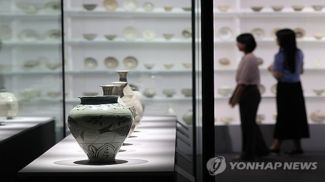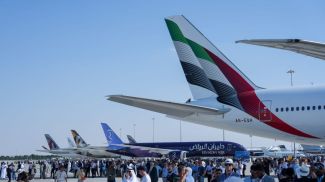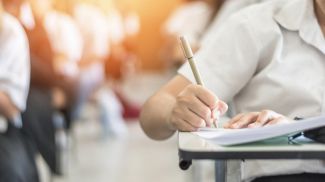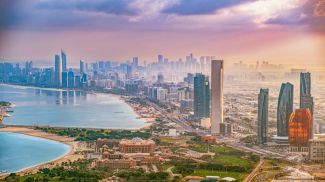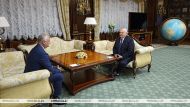New institution hosts 900 items on loan from its Beijing counterpart
HONG KONG, 14 July (BelTA - China Daily). - At the newly opened Hong Kong Palace Museum, a white-glazed ceramic pillow featuring a boy lying on a couch attracts countless visitors who marvel at its exquisite molding.
Dating to the Song Dynasty (960-1279), the artifact is a rare masterpiece that delighted numerous dignitaries in ancient times. During the Qing Dynasty (1644-1911), Emperor Qianlong (1711-99) even wrote many poems about it.
With more than 900 national treasures on loan from the Palace Museum of Beijing, the ceramic pillow is on display to mark the Hong Kong institution's grand opening.
The museum opened just two days after Hong Kong celebrated the 25th anniversary of its return to the motherland on July 1.
Before being flown to Hong Kong from Beijing, the treasures were meticulously packaged and preserved in wooden boxes with precise temperature and humidity controls. They also underwent a number of security and anti-pandemic checks before leaving the Chinese capital.
The items, ranging from paintings and bronzeware to embroidery, span the nation's rich civilization and 5,000-year history. Some have never been on public display before.
The loan of the treasures to Hong Kong is also the largest since the Beijing Palace Museum was established in 1925.
After a planning and construction period of more than six years, the much-anticipated Hong Kong museum, which is situated in the West Kowloon Cultural District, opened to the public on July 3. Even though the arrival of a typhoon delayed the opening by a day, this failed to dampen enthusiasm among art lovers in the city.
Before the museum opened at 9 am, eager visitors lined up to view the treasures. Some residents even dressed in traditional Chinese clothing for the occasion.
Timothy Chan, a 29-year-old museum lover who lives in the city, was among the first group of visitors. He said it was an unforgettable experience to see the treasures in Hong Kong, adding that he used to visit the Palace Museum of Beijing to view its cultural relics.
Due to the pandemic, it is now difficult for Chan to visit Beijing, but the opening of the Hong Kong museum gives him another option. Describing the new institution as a "cultural feast" for museum lovers, he said he believes it will help increase desire among local residents to learn more about Chinese culture.
Han Yang, a mother in her 30s, visited the museum with her family, including her son, who attends kindergarten. She said she was extremely happy to get a close look at the rarely-seen cultural relics, adding that her son was also amazed by the collections.
Some 85 percent of the 140,000 admission tickets for the first month of the relics exhibition had been sold by July 2.
Global arts hub
Louis Ng Chi-wa, director of the new museum, said earlier that establishing the institution in the city is a fitting tribute to local residents' affinity for Chinese culture and also Hong Kong's standing as a cultural hub.
Ng, a veteran museum expert and historian, said Hong Kong people have great enthusiasm for the nation's time-honored history and culture.
In 2007, to mark the 10th anniversary of Hong Kong's return to the motherland, the Beijing Palace Museum loaned the original copy of the classic Chinese painting Along the River During the Qingming Festival to Hong Kong for exhibition, creating a sensation in the city. The renowned painting, which is more than 5 meters long, depicts a scene on Tomb Sweeping Day during the Song Dynasty in present-day Kaifeng, Henan province.
Created by Northern Song painter Zhang Zeduan, the artwork offers a view of life in what was then Bianjing, the dynastic capital and the world's most prosperous metropolis at the time. In 2010, a digital version of the painting was also displayed in Hong Kong, attracting some 930,000 visitors. Related souvenirs sold out in just two hours.
Ng believes that with a Palace Museum now open in the city, Hong Kong people have more opportunities to view exhibitions and appreciate Chinese culture.
Moreover, by establishing a foothold in Hong Kong, the museum can help Chinese culture go global, bridging the world's diverse civilizations, Ng said. He added that many of his team members have decades of experience working overseas, and they are skilled at telling China's story to world audiences.
"The team is quite well-known to foreign visitors who come to see relics, especially those representing Chinese culture. As a result, we are able to convey the core of our culture in a way that is easily accepted by such visitors," Ng said.
After hosting its opening displays, the Hong Kong museum will stage a special joint exhibition with a European museum, featuring the collections of Chinese emperors during the Ming (1368-1644) and Qing dynasties, along with those of European royalty spanning 600 years, Ng added.
He also hopes to showcase other overseas cultures, such as those in Central Asian and Islamic regions, which have rarely been on display in Hong Kong. Exhibitions themed on the Guangdong-Hong Kong-Macao Greater Bay Area and other mainland regions are also being considered.
Daisy Wang Yiyou, the museum's deputy director, who has years of overseas work experience, said the institution will not be limited to Chinese art. It will also offer a Hong Kong perspective and a global vision, presenting the finest items from the Beijing Palace Museum and other important global cultural institutions.
"Our starting point is Chinese art, but our goal is broader than that," Wang said.
Next year, the Hong Kong museum plans to display relics from Sanxingdui, a world-renowned Bronze Age site that flourished in present-day Sichuan province. After being exhibited in the city, the relics will be shown at museums in the United States.
Ng said many collectors keen to contribute to the nation's cultural development have donated high-quality ancient items to his team. By early last month, the museum had received six batches of donations worth a total 500 million yuan ($74.7 million), he said.
More than exhibitions
Plans have been drawn up by Ng's team to strengthen the Hong Kong museum's educational role.
To attract public interest, a 1,600-square-meter space has been designated to host activities such as the restoration of cultural relics. To establish long-term collaboration with schools, the team has set up a department to help promote Chinese history and culture on campuses, Ng said.
A book will be compiled and provided to teachers to introduce the relics to students. Ng is also considering taking mobile workshops featuring the restoration of cultural relics to the community or schools, as part of plans to educate the public about Chinese culture.
Kevin Yeung Yun-hung, the Hong Kong secretary for culture, sports and tourism, hopes the new museum will boost local residents' national identity by immersing them in traditional Chinese culture.
When the museum first opened to the public, Yeung said this was a successful example of using the advantages of the "one country, two systems "policy to tell China's story to the world.
In recent years, the Beijing Palace Museum has introduced ancient Chinese culture to the public by displaying items such as umbrellas with traditional Chinese art, along with colorful ceramic-glazed tea sets. There has been high demand among young people to view such items on mainstream e-commerce platforms.
The Hong Kong Palace Museum plans to invite local artists to design cultural products based on treasures in the Forbidden City, and to collaborate with the Beijing museum in other fields. Counters selling items such as T-shirts, canvas bags, notebooks, stamps and stickers have been set up at the Hong Kong institution.
Heralded as Chinese culture's "window on the world", the new museum, which resembles a square Chinese cauldron with a gold facade, is situated on the western tip of the West Kowloon Cultural District. It aims to attract visitors from around the world.
Inspired by tradition
While the new institution will complement the Beijing Palace Museum, Rocco Yim, the architect responsible for the project, stresses that he was inspired by Chinese tradition, but not enslaved by it.
Yim has designed many prestigious landmarks in Hong Kong, including Tai Kwun, the former Central Police Station compound that was transformed into an arts hub.
"The Hong Kong museum is not going to be a heritage building for another 200 or 300 years. For now, it acts as a piece of contemporary architecture that reflects the cultures of our time, both urban culture and the way we appreciate things. So, this building is part of a city and a piece of the jigsaw that has to fit perfectly with the original thinking behind the West Kowloon Cultural District," Yim said.
"At the Beijing museum, you can see traditional construction methods, building components and materials, whereas in the Hong Kong museum, we have used contemporary building materials and construction methods."
The design for the Hong Kong museum also incorporates several sustainable features. For example, it has a wider roof but a smaller base than other such buildings, mainly because Yim wanted to allocate as much open and green space as possible for public use at ground level.
Ng said the museum benefits from the city's abundant technological resources. For instance, the team invited Jeffrey Shaw, director of City University of Hong Kong's Center for Applied Computing and Interactive Media to design artworks for the institution. The Australian scholar has been involved in numerous art projects in China, including some in Dunhuang, Gansu province, a city with rich cultural heritage.
An interactive sensing device at the Hong Kong museum brings to life a painting themed on horses by Giuseppe Castiglione, an Italian artist who painted for the royal family during the Qing Dynasty. When visitors view this work, the horses appear to approach them.
Visitors can also create their own artistic "masterpieces" by using new media installations-combining elements of well-known paintings from various dynasties.
"This interaction with visitors is vitally important to us. The Hong Kong Palace Museum is not only an institution that focuses on cultural relics, but also a cultural site centered on visitors," Ng said.
Future expectations
Congratulating the museum on its opening, Paul Surtees, a veteran commentator on the arts scene in Hong Kong, said that sharing culture and loaning exhibitions will do much to enrich the city's cultural diversity.
"Such cultural exchanges may well produce a better atmosphere for cooperation, at least in respect of culture," Surtees said.
He suggested that schools and colleges arrange trips for students to view exhibits at the museum, adding that he hopes the Forbidden City collections will also be exhibited in Macao and Taiwan.
Hong Kong lawmaker Kenneth Fok Kai-kong, who represents the sports, performing arts, culture and publications sector, described the new museum's facilities and design as "world-class". He said he hoped the institution could encourage more cross-cultural collaboration to further underpin the city's role as a global arts hub.
Fok also has high hopes that the museum can emulate its Beijing counterpart's success in showcasing cultural and creative products.
He said the Hong Kong institution carries the hopes of many people at home and abroad, as it translates Chinese culture for a global audience.




